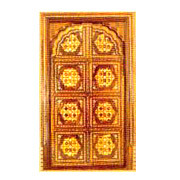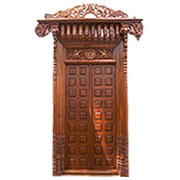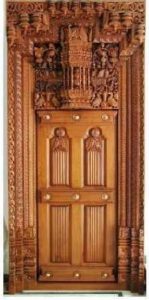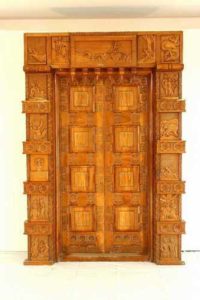
Traditional Wooden Door
This door is a reproduction of the doors belonging to the rajputana havelis in the reign of raja todarmal (one of the nine gems in the court of emperor akbar) in jaipur, rajasthan. The rajputs were a rich clan in both tradition and history. Honour was a matter of pride and they would lay down their life for it. The rajput chieftains were spread over vast tracts of desert land and had to do with what little water resources they could muster. thus the houses were built around oasis / fresh water springs in the desert. This group housing were called havelis (mini palaces) which housed the chieftains family and also those of his subordinates and servants. The haveli was built like a fortress with huge thick walls and ramparts to see the enemy from far and mount a counter attack. the mahadwara of the haveli was set into a stone frame and was of double thickness, having embellishments of brass and iron to give both beauty and strength. The pointed brass studs thwarted attacks from enemy elephants who were used to push open the doors. the umbro or frame was made of marble and inlaid with precious stones and gems. The shutters were made of sheesham (rosewood), carved and inlaid with brass. They had metal plates and iron reinforcements supported with iron hinges and tower bolts. A solid wooden beam, the width of doorway was placed in between to lock the doors at night. the pattern of inlay work was similar to the design of rangoli, an ancient form of drawing on the floor – geometric design to enhance the vastu of the home and add colour to the festivities. The doors were so heavy, that they were operated by their dwarapalakas. the ancient rajasthani art has almost died out due to non-availability of natural wood and increasing cost of labour.






